
The Louvre, or the Louvre Museum, is a national art museum in Paris, France. It is located on the Right Bank of the Seine in the city's 1st arrondissement and home to some of the most canonical works of Western art, including the Mona Lisa and the Venus de Milo. The museum is housed in the Louvre Palace, originally built in the late 12th to 13th century under Philip II. Remnants of the Medieval Louvre fortress are visible in the basement of the museum. Due to urban expansion, the fortress eventually lost its defensive function, and in 1546 Francis I converted it into the primary residence of the French Kings.
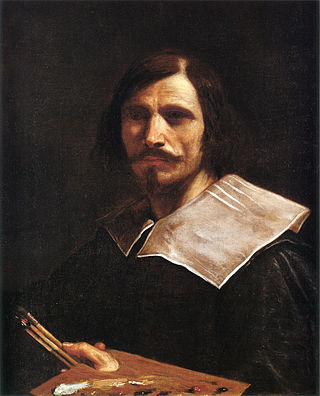
Giovanni Francesco Barbieri, better known as (il) Guercino, was an Italian Baroque painter and draftsman from Cento in the Emilia region, who was active in Rome and Bologna. The vigorous naturalism of his early manner contrasts with the classical equilibrium of his later works. His many drawings are noted for their luminosity and lively style.
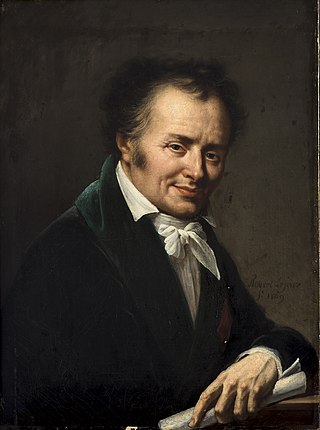
Dominique Vivant, Baron Denon was a French artist, writer, diplomat, author, and archaeologist. Denon was a diplomat for France under Louis XV and Louis XVI. He was appointed as the first Director of the Louvre museum by Napoleon after the Egyptian campaign of 1798–1801, and is commemorated in the Denon Wing of the modern museum and in the Dominique-Vivant Denon Research Center. His two-volume Voyage dans la basse et la haute Egypte, 1802, was foundational for modern Egyptology.
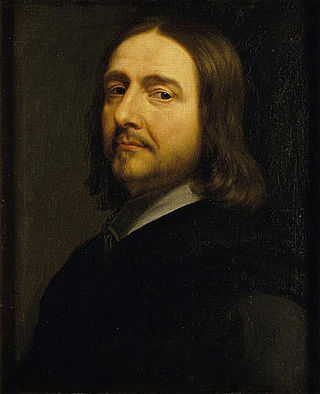
Philippe de Champaigne was a Brabançon-born French Baroque era painter, a major exponent of the French school. He was a founding member of the Académie royale de peinture et de sculpture in Paris, the premier art institution in the Kingdom of France in the eighteenth century.

Antoine Coypel was a French painter, pastellist, engraver, decorative designer and draughtsman. He became court painter first to Philippe I, Duke of Orléans, and later to King Louis XV. He became director of the Académie Royale. He was given the title of Garde des tableaux et dessins du roi, a function which combined the role of director and curator of the king's art collection. He was raised to the nobility by the French king. He is known for his history paintings, biblical, mythological and allegorical works, portraits and genre scenes.

Domenico Fetti was an Italian Baroque painter who had been active mainly in Rome, Mantua and Venice.

The Transfiguration is the last painting by the Italian High Renaissance master Raphael. Cardinal Giulio de Medici – who later became Pope Clement VII – commissioned the work, conceived as an altarpiece for Narbonne Cathedral in France; Raphael worked on it in the years preceding his death in 1520. The painting exemplifies Raphael's development as an artist and the culmination of his career. Unusually for a depiction of the Transfiguration of Jesus in Christian art, the subject is combined with the next episode from the Gospels in the lower part of the painting. The work is now in the Pinacoteca Vaticana in the Vatican City.
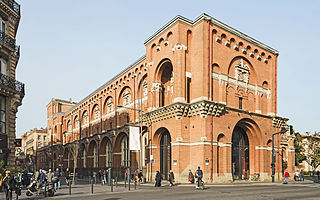
The Musée des Augustins de Toulouse is a fine arts museum in Toulouse, France which conserves a collection of sculpture and paintings from the Middle Ages to the early 20th century. The paintings are from throughout France, the sculptures representing Occitan culture of the region with a particularly rich assemblage of Romanesque sculpture.

The Diana of Versailles or Artemis, Goddess of the Hunt is a slightly over-lifesize marble statue of the Roman goddess Diana with a deer. It is currently located in the Musée du Louvre, Paris. The statue is also known as Diana with a Doe, Diana Huntress, and Diana of Ephesus. It is a partially restored Roman copy of a lost Greek bronze original attributed to Leochares, c. 325 BC.
Events from the year 1619 in art.

The Furietti Centaurs are a pair of Hellenistic or Roman grey-black marble sculptures of centaurs based on Hellenistic models. One is a mature, bearded centaur, with a pained expression, and the other is a young smiling centaur with his arm raised. The amorini are missing that once rode the backs of these centaurs, which are the outstanding examples of a group of sculptures varying the motif.

Bartolomeo Cavarozzi (1587–1625), occasionally referred to as Bartolomeo Crescenzi, was an Italian caravaggisti painter of the Baroque period. Cavarozzi's work begin receiving increased admiration and appreciation from art historians in the last few decades of the 20th century, emerging as one of the more distinct and original followers of Caravaggio. He received training from Giovanni Battista Crescenzi in Rome and later traveled to Spain alongside his master for a few years where he achieved some renown and was significant in spreading "Caravaggism" to Spain before returning to Italy. His surviving works are predominantly Biblical subjects and still-life paintings, although older references note he "was esteemed a good painter especially of portraits".
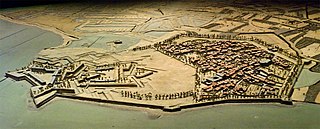
The Musée des Plans-Reliefs is a museum of military models located within the Hôtel des Invalides in the 7th arrondissement of Paris, France.

The Musée Bonnat-Helleu is an art museum in Bayonne, Nouvelle-Aquitaine, France. The museum was created in 1901 when Bayonne-born painter Léon Bonnat gave his extensive personal collections of art – notably an exceptional drawing collection – as well as many of his paintings to the City of Bayonne. Subsequent donors enriched the collections of the Bonnat Museum with major gifts in 1936, 1989, 1997 and 2010, making its holdings one of the largest collections of art in southern France.

Don Pedro of Toledo Kissing Henry IV's Sword was originally a painting of 1814 in the Troubador style by the French artist Jean-Auguste-Dominique Ingres, showing the Spanish ambassador Pedro Álvarez de Toledo, 5th Marquis of Villafranca kissing the sword of Henry IV of France in the salle des Caryatides of the Louvre Palace. The 1814 painting is now lost. Between 1819 and 1832, Ingres painted three additional versions of the subject.
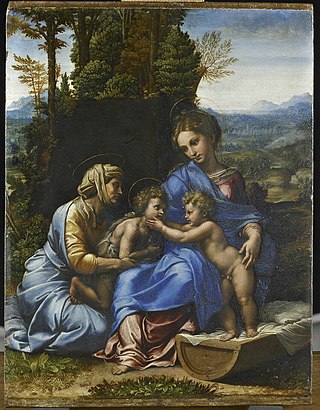
The Small Holy Family is an oil-on-panel painting by Raphael and assistants, now in the Louvre in Paris. Its name distinguishes it from his Great Holy Family, also in the Louvre. It is signed and dated "RAPHAEL VRBINAS S[anti] PINGEBAT MDXVIII" on the hem of the Madonna's garment.
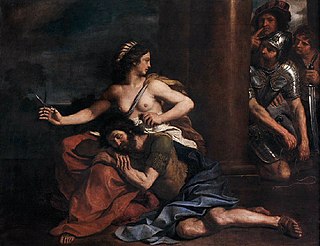
Samson and Delilah is a 1654 painting by the Italian Baroque painter Giovanni Francesco Barbieri. It is on display in the Musée des Beaux-Arts of Strasbourg, France. Its inventory number is 316.

The Abduction of Helen is a 1628-1629 oil on canvas painting by Guido Reni, now in the Louvre Museum in Paris.

















